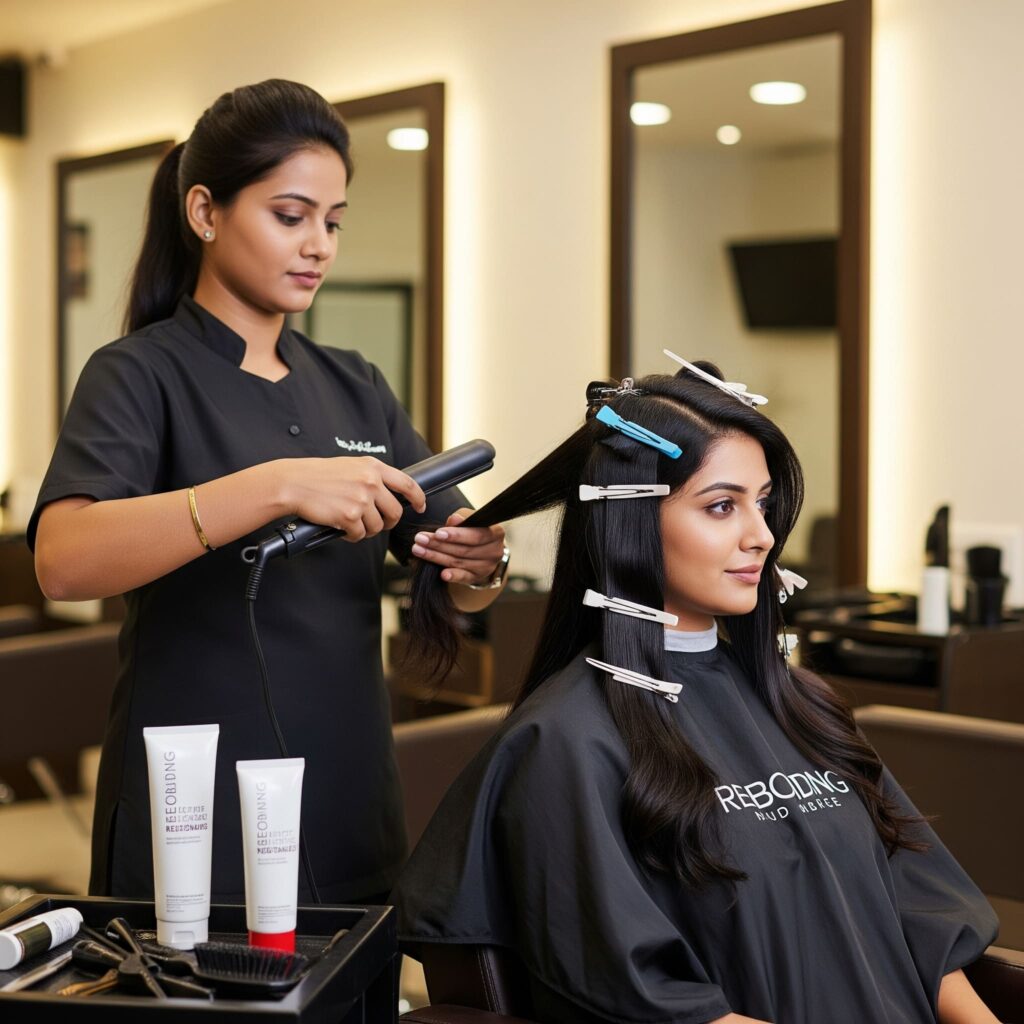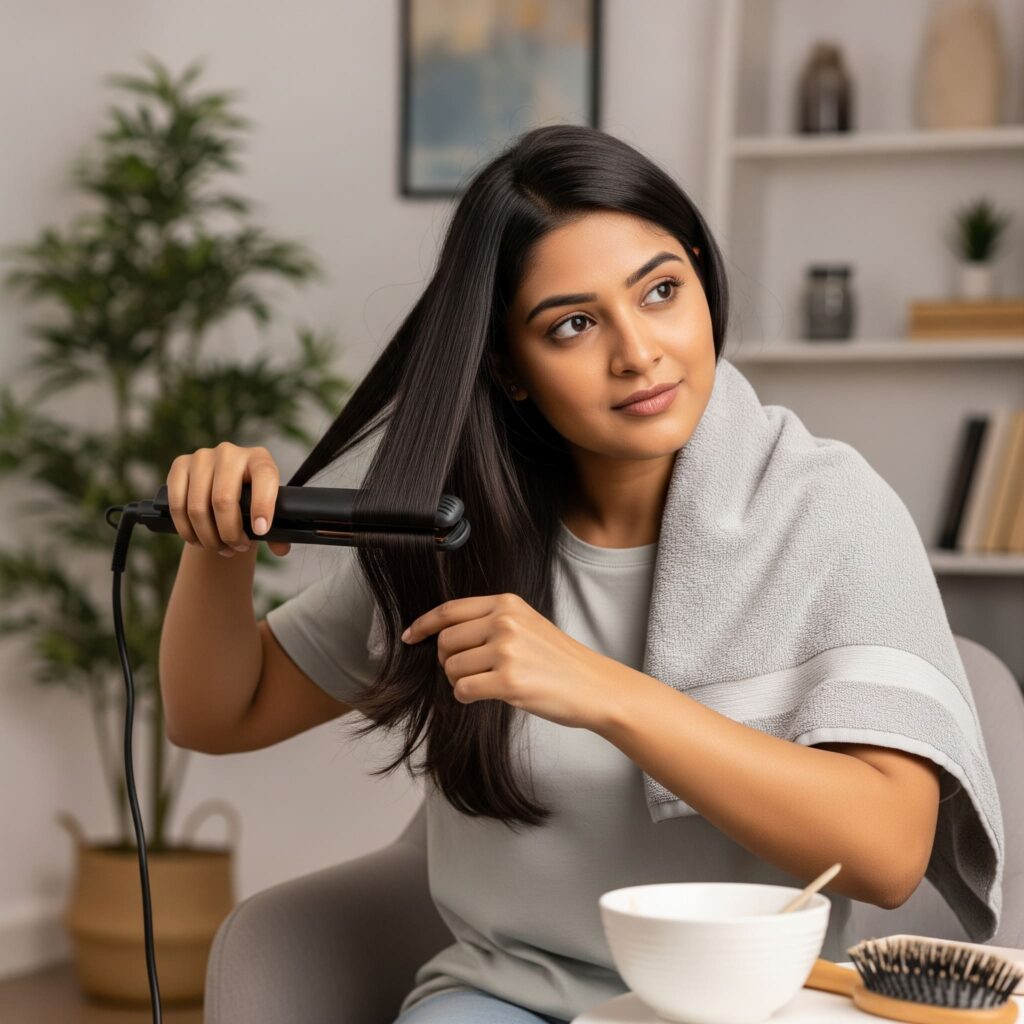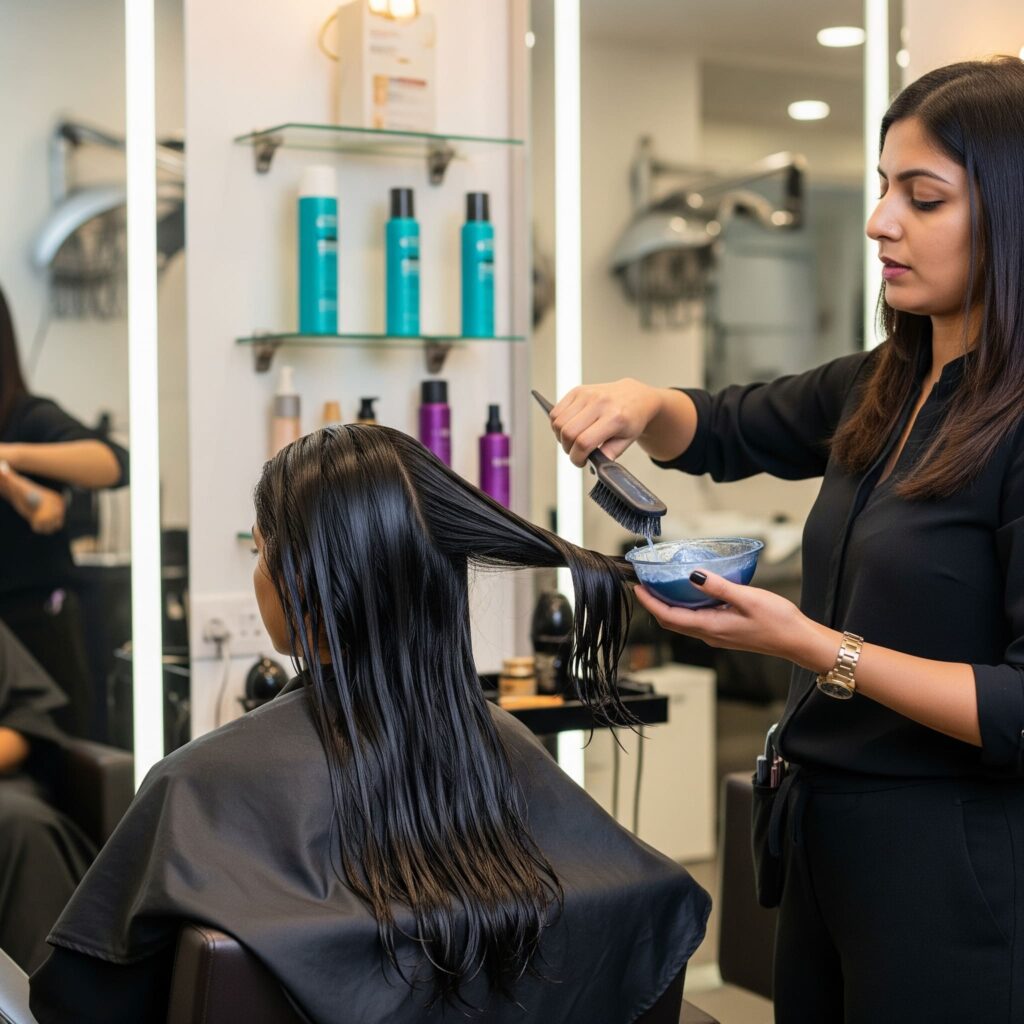Hair rebonding permanently alters hair’s molecular structure to achieve pin-straight, glossy hair, making it ideal for dramatic straightening, but it’s more damaging and expensive with a longer, time-consuming process. Hair smoothing is a less permanent, milder treatment that reduces frizz and adds shine, resulting in a more natural, soft look with less damage and a shorter duration, though it doesn’t provide the same level of straightness as rebonding. The choice depends on whether you want extreme, permanent straightness (rebonding) or a more subtle, temporary, and frizz-free result (smoothing).
Hair rebonding vs hair smoothening both provide sleek, straight hair but differ in treatment and results. Hair rebonding vs hair smoothening varies as rebonding chemically restructures hair for a pin-straight look, while smoothening uses keratin for a softer, natural shine. When comparing hair rebonding vs hair smoothening, rebonding lasts longer but needs more maintenance, whereas smoothening is gentler on the hair. Understanding hair rebonding vs hair smoothening helps you choose the ideal treatment for your hair type and desired style.
Table of Contents
What Is Hair Rebonding?
Hair rebonding vs hair smoothening are popular chemical hair treatments but have distinct processes and results. Hair rebonding is a chemical hair straightening process that breaks natural hair bonds, reshapes them with a flat iron, and locks them in, followed by neutralization. This treatment offers pin-straight, sleek hair that can last up to six months, depending on hair care and growth. The difference between hair rebonding vs hair smoothening lies in the permanent alteration of hair structure, making rebonding ideal for naturally curly or wavy hair wanting a dramatic straight look.

In contrast, hair smoothening is a milder treatment that smooths hair and reduces frizz without breaking hair bonds. Hair rebonding vs hair smoothening shows that smoothening enhances shine and manageability with less damage, while rebonding provides a more permanent straightening effect. The difference between rebonding and hair smoothening is significant in terms of intensity, longevity, and hair texture change, helping individuals choose the best option for their desired hairstyle and hair health. Hair rebonding vs hair smoothening ensures that people can decide based on their hair type and stylistic preferences.
Benefits of Hair Rebonding
Hair rebonding vs hair smoothening are two popular treatments offering smooth and manageable hair. Hair rebonding vs hair smoothening differs mainly in how they affect hair structure: hair rebonding permanently restructures hair bonds for straight, sleek hair, while smoothening adds shine and reduces frizz without altering the molecular structure. When considering hair rebonding vs hair smoothening, the primary difference lies in permanency and intensity, with rebonding providing a longer-lasting effect. Choosing between hair rebonding vs hair smoothening depends on the desired look and hair type, but understanding their differences helps make the right choice.
- Achieves perfectly straight, smooth hair with lasting effects
- Reduces frizz and tangles for easier styling and maintenance
- Makes hair appear shinier and more polished
- Saves time on daily straightening for three to six months
- Suitable for people with curly or resistant hair types needing permanent straightening
Side Effects of Hair Rebonding
Hair rebonding vs hair smoothening treatments both aim to give you smooth, manageable hair, but they differ significantly. Hair rebonding is a chemical process that straightens hair permanently by breaking and restructuring bonds, while hair smoothening coats the hair with proteins for a softer, shinier look without permanently altering the structure.
When comparing hair rebonding vs hair smoothening, the key difference lies in the intensity and longevity of the results, with rebonding providing a pin-straight effect lasting months. Side effects of hair rebonding can include dryness and damage due to the strong chemicals used, unlike the gentler hair smoothening. Understanding the difference between hair rebonding vs hair smoothening can help you choose the best treatment for your hair type and style needs. Hair rebonding involves harsh chemicals and heat, leading to some risks:
- Hair dryness and brittleness due to chemical damage
- Vulnerability to breakage of aftercare is inadequate
- Scalp irritation or sensitivity from strong chemicals
- Regrowth causes contrast between treated and untreated hair
- Overprocessing can lead to hair damage or thinning
Professional application and strict post-care reduce these risks. Explore waxing vs shaving to find the best hair removal method.

What Is Hair Smoothening?
Hair smoothening uses gentler chemicals and treatments like keratin or amino acids to relax curls and reduce frizz without completely altering hair structure. Unlike hair rebonding, which chemically restructures hair for a pin-straight look, smoothening enhances hydration and softens the curl pattern for natural smoothness. When comparing hair rebonding vs hair smoothening, smoothening offers a soft, manageable, and shiny finish lasting 2 to 4 months with less damage. The difference between hair straightening and rebonding relates to the permanency and intensity of the chemical process, whereas hair rebonding vs hair smoothening differs in their effect on hair texture and structure.
Hair smoothening reduces frizz without straightening hair fully, while rebonding permanently straightens hair by changing its molecular bonds. Understanding the difference between hair rebonding vs hair smoothening helps choose the best treatment for your hair type and desired look. With hair rebonding vs hair smoothening, the latter is less damaging and gives a more natural finish, making it suitable for those who prefer manageable and shiny hair without the extreme straightness. Hair rebonding vs hair smoothening treatments differ significantly, so selecting the right one depends on whether you want long-lasting straight hair or smooth, frizz-free hair with some natural texture.

Benefits of Hair Smoothening
Hair rebonding vs hair smoothening offers distinct advantages: hair smoothening reduces frizz and adds natural shine, making hair more manageable, while rebonding provides long-lasting straightness. The difference between hair straightening and rebonding lies in their intensity and effect; smoothening is milder and preserves some texture. When comparing hair rebonding vs hair smoothening, smoothening is less damaging and ideal for enhancing hair softness. Understanding the difference between hair rebonding vs hair smoothening will help you choose the right treatment for sleek, healthy hair.
- Softens and smoothens hair while maintaining natural texture
- Controls frizz and adds shine for healthier-looking hair
- Less damaging than rebonding due to milder chemicals
- Adds moisture and improves hair manageability
- Suitable for wavy, slightly curly, or dry hair needing frizz control
Side Effects of Hair Smoothening
Hair rebonding vs hair smoothening both aim to give sleek hair, but the side effects of hair smoothening can include increased hair fall and damage to hair follicles. When comparing hair rebonding vs hair smoothening, the difference between hair straightening and rebonding lies in the method used, with rebonding permanently altering the hair’s structure. Hair rebonding vs hair smoothening treatments work by breaking and reforming bonds in hair, which may cause dryness and split ends. The difference between rebonding and hair smoothening is subtle but important to consider when evaluating potential risks and results.Though milder, side effects include:
- Temporary scalp irritation or allergic reactions to keratin or smoothing agents
- Hair may become weighed down or limp if overused
- Possible dryness without proper hydration after treatment
- Results are temporary and require reapplication every few months
Discover the key differences between pedicure and manicure in this blog.

What Is The Difference Between Hair Rebonding vs Hair Smoothening?
Hair rebonding vs hair smoothening are popular hair treatments with key differences. Hair rebonding straightens hair permanently by chemically altering its structure, while smoothening smooths and reduces frizz without molecular changes. The difference between hair straightening and rebonding lies in the process intensity and results. Hair rebonding vs smoothening varies in longevity, with rebonding lasting longer but causing more damage. Understanding the difference between rebonding and hair smoothening helps you choose the best option for your hair type and desired look.
| Feature | Hair Rebonding | Hair Smoothening |
| Chemical Process | Strong chemicals break and restructure hair bonds | Milder chemicals relax hair without changing structure |
| Result | Permanently straight, pin-straight hair | Softer, smoother, frizz-free with some natural texture |
| Duration | 6 months or more | 2 to 4 months |
| Hair Damage Potential | Higher due to strong chemicals and heat | Lower, less harsh effects |
| Suitable Hair Type | Curly or wavy hair needing full straightening | Wavy or frizzy hair needing smoothness without losing waves |
| Maintenance | Requires strict aftercare and touch-ups | Requires regular hydration and occasional touch-ups |
| Texture After Treatment | Straight, sleek | Smooth, shiny, natural-looking |
Compare waxing and laser hair removal to find your perfect method.
How To Take Care Of Hair After Rebonding & Smoothening?
Taking care of your hair after treatment is essential, especially when considering hair rebonding vs hair smoothening. To maintain the effects and keep your hair healthy, use sulfate-free shampoos and avoid washing your hair for at least 3 days. Understanding the difference between hair straightening and rebonding helps in choosing the right aftercare routine. Whether it’s hair rebonding vs smoothening or knowing the difference between rebonding and hair smoothening, proper nourishment and protection are key to long-lasting results.
- Use sulfate-free shampoos and nourishing conditioners to maintain treatment effects.
- Avoid excessive heat styling and exposure to chlorinated water.
- Regularly apply hair masks and oils to replenish moisture.
- Do not wash hair for at least 48 hours post-treatment.
- Detangle gently to prevent breakage.
- Schedule touch-ups as recommended by your stylist.
Discover which suits your hair better: gentle hair cleanser or shampoo.

Who Wins The Battle Of Hair Rebonding Vs Hair Smoothening ?
The battle of hair rebonding vs hair smoothening depends on your hair type and desired look. While hair rebonding gives a pin-straight, long-lasting effect, smoothening offers natural shine and manageability. The difference between hair straightening and rebonding lies in the intensity and results, with rebonding being more permanent. Choosing between hair rebonding vs smoothening requires understanding the difference between rebonding and hair smoothening to get the best fit for your hair needs.Deciding between hair smoothening or rebonding which is better depends largely on your hair type, lifestyle, and desired look:
- If you want completely straight, sleek hair and are prepared for chemical exposure and maintenance, rebonding is suitable.
- If you prefer softer, naturally flowing styles with frizz control and less damage, smoothening is preferable.
- Consider hair health and consult with professionals for personalized assessment.
Discover key differences between face scrub and face wash benefits.
Conclusion
The choice between hair rebonding vs hair smoothening depends on durability, hair type compatibility, and maintenance. Understanding the difference between hair straightening and rebonding is crucial for making the right choice. While hair rebonding vs smoothening offers distinct benefits and risks, the difference between rebonding and hair smoothening lies in the intensity and results. Proper care after either treatment ensures your hair stays healthy, shiny, and beautiful.
For personalized Hair Smoothening advice and expert tips tailored to your unique hair needs, visit Peacock Salon in Vashi, Navi Mumbai. Our skilled stylists specialize in healthy, results-driven hair smoothening treatments and hair services for all hair types. Find us at Mahavir Center, Shop No. 20, 21, 21A, 22, next to Golden Punjab Hotel, Sector 17, Vashi, or call +91 9324774567 to book your consultation and refresh your hair care routine.
Hair Rebonding vs Hair Smoothening – FAQs
What is the difference between hair straightening and rebonding?
Hair straightening may refer to temporary heat method; rebonding permanently restructures hair bonds for pin-straight look.
What is the difference between rebonding and hair smoothening?
Rebonding uses strong chemicals for permanent straightening; smoothening uses milder agents to soften hair, maintain natural waves.
What are the benefits of hair rebonding?
Long-lasting straight and silky hair, frizz control, and reduced styling time.
What are the benefits of hair smoothening?
Soft, manageable, frizz-free hair with natural look, less damage than rebonding.
What are the side effects of hair smoothening?
Potential scalp irritation, hair limpness, dryness; results last 2-4 months.
What is the side effect of rebonding hair?
Hair dryness, brittleness, potential breakage, and scalp sensitivity due to strong chemicals.
Hair smoothening or rebonding which is better?
Choose based on desired hair texture; rebonding for full straightening, smoothening for softer, manageable hair.
How long do rebonding and smoothening last?
Rebonding lasts around 6 months, smoothening about 2-4 months.
Can damaged hair be rebonded or smoothened?
Healthy hair responds better; damaged hair may worsen with rebonding but smoothening is gentler.
How to care for hair after rebonding or smoothening?
Use sulfate-free products, avoid heat, moisturize regularly, and follow professional aftercare guidelines.
